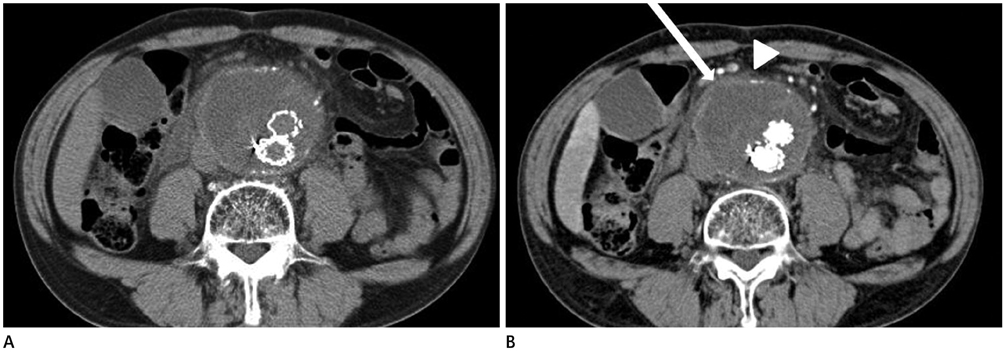J Korean Soc Radiol.
2014 Mar;70(3):195-199. 10.3348/jksr.2014.70.3.195.
Unusual Perigraft Abscess Formation Associated with Stent Graft Infection after Endovascular Aortic Repair of Abdominal Aortic Aneurysm: A Case Report
- Affiliations
-
- 1Department of Radiology, Chungnam National University Hospital, Chungnam National University School of Medicine, Daejeon, Korea. haneul88@hanmail.net
- 2Department of Surgery, Chungnam National University Hospital, Chungnam National University School of Medicine, Daejeon, Korea.
- 3Division of Cardiology, Department of Internal Medicine, Chungnam National University Hospital, Chungnam National University School of Medicine, Daejeon, Korea.
- KMID: 1839431
- DOI: http://doi.org/10.3348/jksr.2014.70.3.195
Abstract
- Although a stent graft infection after endovascular aortic repair (EVAR) of abdominal aortic aneurysm (AAA) is a rare complication, it carries a high mortality and morbidity rate. We report a rare case of stent graft infection that led to an unusual perigraft abscess formation without any associated aortoenteric fistula two years after the EVAR of AAA.
MeSH Terms
Figure
Reference
-
1. Hobbs SD, Kumar S, Gilling-Smith GL. Epidemiology and diagnosis of endograft infection. J Cardiovasc Surg (Torino). 2010; 51:5–14.2. Sharif MA, Lee B, Lau LL, Ellis PK, Collins AJ, Blair PH, et al. Prosthetic stent graft infection after endovascular abdominal aortic aneurysm repair. J Vasc Surg. 2007; 46:442–448.3. Laser A, Baker N, Rectenwald J, Eliason JL, Criado-Pallares E, Upchurch GR Jr. Graft infection after endovascular abdominal aortic aneurysm repair. J Vasc Surg. 2011; 54:58–63.4. Lyons OT, Patel AS, Saha P, Clough RE, Price N, Taylor PR. A 14-year experience with aortic endograft infection: management and results. Eur J Vasc Endovasc Surg. 2013; 46:306–313.5. Pryluck DS, Kovacs S, Maldonado TS, Jacobowitz GR, Adelman MA, Charles HC, et al. Percutaneous drainage of aortic aneurysm sac abscesses following endovascular aneurysm repair. Vasc Endovascular Surg. 2010; 44:701–707.6. Masuhara H, Fujii T, Watanabe Y, Koyama N, Tokuhiro K. Antibiotics and drainage for treating stent-graft infection after EVAR. Ann Vasc Dis. 2012; 5:462–465.7. Ducasse E, Calisti A, Speziale F, Rizzo L, Misuraca M, Fiorani P. Aortoiliac stent graft infection: current problems and management. Ann Vasc Surg. 2004; 18:521–526.8. Vogel TR, Symons R, Flum DR. The incidence and factors associated with graft infection after aortic aneurysm repair. J Vasc Surg. 2008; 47:264–269.9. Numan F, Gulsen F, Solak S, Cantasdemir M. Management of endograft infections. J Cardiovasc Surg (Torino). 2011; 52:205–222.10. Ferrar DW, Roberts AK, Lawrence-Brown MM, McLellan D, Semmens JB. Infected endoluminal stent-graft: implications for endotension, late endoleaks, and prophylactic antibiotics. J Endovasc Ther. 2005; 12:654–659.
- Full Text Links
- Actions
-
Cited
- CITED
-
- Close
- Share
- Similar articles
-
- Endovascular Repair of Thoracic Aortic Aneurysm Using a Custom-made Fenestrated Stent Graft to Preserve the Left Subclavian Artery
- Endovascular Stent-Graft Placement and Secondary Intervention for Abdominal Aortic Aneurysm in a Patient who had a Previously Inserted Iliac Stent
- Endovascular Repair of a Juxtarenal Abdominal Aortic Aneurysm Using a Chimney Graft
- Endovascular Treatment of Abdominal Aortic Aneurysm
- Endovascular aortic aneurysm repair using a bifurcated stent graft in a patient with femoro-femoral bypass




